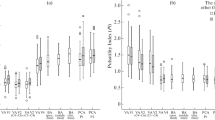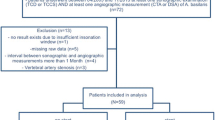Summary
We have examined 10,162 patients during the past 5 years using directional continuous-wave Doppler sonography of the vertebral arteries. On the basis of 1,989 retrograde brachial angiograms, we have developed sonographic criteria for demonstrating a significant increase in the peripheral resistance of both distal vertebral arteries and/or the basilar artery. All 11 cases of basilar artery stenosis of at least 60% reduction in lumen diameter (as shown by angiography) exhibited an approximately 40% or higher reduction in the sum of the modified Pourcelot indices of both vertebral arteries in comparison with age-matched controls. The 3 stenoses below 60% reduction in lumen diameter were not detected by sonography. Even a good collateral circulation through rete-mirabile anastomoses did not normalize the modified Pourcelot indices. One case of persistent primitive trigeminal artery with thin-calibred vertebral arteries was also detected by sonography. The high percentage of patients with one hypoplastic vertebral artery in the group of basilar artery stenoses indicates an increased risk for atherosclerosis of the basilar and/or the distal vertebral artery in these patients. All 14 angiographically verified occlusions of the basilar artery were detected by sonographic criteria independent of the occlusive localization. Thus, we believe that directional continuous-wave Doppler sonography is a reliable technique for detecting basilar artery stenoses of at least 60% reduction in lumen diameter and basilar artery occlusions.
Zusammenfassung
Wir haben 10162 Patienten innerhalb der letzten fünf Jahre mit der direktionellen Doppler-Sonographie der Vertebralarterien untersucht und im Vergleich mit 1989 retrograden Brachialisarteriographien sonographische Kriterien für den Nachweis einer wesentlichen Widerstandserhöhung im peripheren Gefäßbett beider Vertebralarterien bzw. der A. basilaris entwickelt. Alle 11 Basilarisstenosen von mehr als 60% Lumenreduktion (angiographisch) zeigten unabhängig von ihrer Lokalisation stets eine ca. 40%ige oder höhere Reduktion der Summe der modifizierten Pourcelot-Indices beider Vertebralarterien im Vergleich zu altersentsprechenden Normalwerten. Die 3 Stenosen unter 60% Reduktion des Lumendurchmessers waren sonographisch nicht erfaßbar. Selbst die Ausbildung eines Rete mirabile konnte den peripheren Widerstandsindex nicht normalisieren; auch beidseits kaliberschwache Vertebralarterien im Fall einer A. trigemina primitiva persistens waren sonographisch vorhersagbar. Der hohe Anteil an Patienten mit einseitiger Vertebralishypoplasie in der Gruppe der Basilarisstenosen weist auf ein höheres Risiko dieser Patientengruppe für arteriosklerotische Veränderungen an der A. basilaris bzw. der distalen A. vertebralis hin. Alle 14 angiographisch verifizierten Basilarisobliterationen waren — unabhängig von ihrer Lokalisation — mit den genannten Kriterien Doppler-sonographisch erfaßbar. Wir nehmen daher an, daß die direktionelle Doppler-Sonographie der Vertebralarterien eine sensitive Methode zur Erkennung von Basilarisstenosen mit zumindest 60%iger Reduktion des Lumendurchmessers bzw. von Basilarisobliterationen darstellt.
Similar content being viewed by others
Literatur
Archer CR, Horenstein S (1977) Basilar artery occlusion. Clinical and radiological correlation. Stroke 8:383–390
Biedert S, Winter R, Betz H, Reuther R (1985) Die Doppler-Sonographie beiintracraniellen Zirkulationsstörungen der A.carotis interna. Eine Doppler-sonographisch-angiographische Vergleichsuntersuchung. Eur Arch Psychiatr Neurol Sci 234:378–389
Büdingen HJ, Reuthen GM von, Freund HJ (1982) Doppler-Sonographie der extracraniellen Hirnarterien. Thieme, Stuttgart
Caplan LR (1979) Occlusion of the vertebral or basilar artery. Follow-up analysis of some patients with benign outcome. Stroke 10:277–282
Fields WS, Ratinov G, Weibel J, Campos RJ (1966) Survival following basilar artery occlusion. Arch Neurol 15:463–471
Krayenbühl H, Yasargil MG (1957) Die vaskulären Erkrankungen im Gebiet der Arteria Vertebralis und Arteria Basilaris. Thieme, Stuttgart
Lie TA (1968) Congenital anomalies of the carotid arteries. Excerpta Medica Foundation, Amsterdam
Piepgras DG, Sundt TM jr, Forbes GS, Smith HC (1984) Balloon catheter transluminal angioplasty for vertebrobasilar ischemia. In: Berguer R, Bauer RB (eds) Vertebrobasilar arterial occlusive disease. Raven Press, New York, pp 215–224
Pourcelot L (1976) Diagnostic ultrasound for cerebral vascular diseases. In: Donald I, Levi S (eds) Present and future of diagnostic ultrasound. John Wiley, New York, pp 141–147
Reutern GM von, Büdingen HJ, Hennerici M, Freund HJ (1976) Diagnose und Differenzierung von Stenosen und Verschlüssen der Arteria carotis mit der Doppler-Sonographie. Arch Psychiatr Nervenkr 222:191–207
Reutern GM von, Büdingen HJ, Freund HJ (1976) Doppler-sonographische Diagnostik von Stenosen und Verschlüssen der Vertebralarterien und des Subclavian-Steal-Syndroms. Arch Psychiatr Nervenkr 222:209–222
Reutern GM von, Voigt K, Ortega-Suhrkamp E, Büdingen HJ (1977) Doppler-sonographische Befunde bei intrakraniellen vaskulären Störungen. Arch Psychiatr Nervenkr 223:181–196
Reutern GM von, Pourcelot L (1978) Cardiac cycle-dependent alternating flow in vertebral arteries with subclavian artery stenoses. Stroke 9:229–236
Reutern GM von, Clarenbach P (1980) Valeur de l'exploration doppler des collatérales cervicales et de l'ostium vertebral dans le diagnostic des sténoses et occlusions de l'artère vertébrale. Ultrasonics 1:153–162
Ringelstein EB, Zeumer H (1982) The role of continuous-wave Doppler sonography in the diagnosis and management of basilar and vertebral artery occlusions, with special reference to its application during local fibrinolysis. J Neurol 228:161–170
Saltzman GF (1959) Patent primitive trigeminal artery studied by cerebral angiography. Acta Radiol 51:329–336
Toole JF (1984) Cerebrovascular disorders, chapter 7, Medical management of transient ischemic attacks. Raven Press, New York, pp 117–124
Winter R, Biedert S, Reuther R (1984) Das Doppler-Sonogramm bei Basilaristhrombosen. Eur Arch Psychiatr Neurol Sci 234:64–68
Author information
Authors and Affiliations
Rights and permissions
About this article
Cite this article
Biedert, S., Betz, H. & Reuther, R. Die Doppler-sonographische diagnose von basilarisstenosen und -obliterationen. Eur Arch Psychiatr Neurol Sci 235, 221–230 (1986). https://doi.org/10.1007/BF00379978
Received:
Issue Date:
DOI: https://doi.org/10.1007/BF00379978




